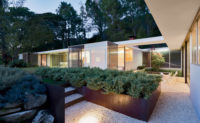Design concept and solution: The initial project began when the family bought a 1791 beech timber barn frame at a nearby auction, and converted it into a 3,200-square-foot living space that takes advantage of the generous size and noble proportions of the frame, while incorporating the slope of the site and its distant views. The location chosen was a remote field out of sight and hearing from the family compound 1,700 yards away. The barn became a retreat for the founding generation—a quiet and serene space with abundant light and views, areas for entertaining, a master bedroom suite, and an indoor exercise pool. The barn is open and light-filled with durable materials and very discreet and efficient mechanical systems. The architect made good use of what was already onsite: stones from the fields were made into foundation walls and trees from the edge of the fields were milled into cabinets and furniture. Many specific site conditions were studied along with the arc of the sun and the shadows of the large mountain behind. The project is integrated into the community at many levels of environmental and historical sensitivity.
Ten years after the barn was completed, the architect was asked by the next generation—the original clients' daughter and son-in-law—to transform the project to accommodate their family—four young children along with their frequent guests. A children’s wing with bedrooms was added, as well as a family room and a pantry snack area, for a total of 2,700 square feet. Extensive landscaping included several terraces, fields, and a pool and pool house that allow for more structured outdoor activities. The children’s wing was sited to maintain views of the distant landscape from the entry and from inside the barn, while preserving the profile of the original pure form of the 1791 frame as the primary identity of the site. The linear form of the addition consists of four equal bedrooms with two shared spaces at each end—the pantry and the family room. The identical size of the four children’s rooms and shared bathrooms earned the wing the nickname “the socialist paradise” in the architect’s office. The rational repetition of the steel frame is both economical and fair to the kids, giving them all the same amount of space and views. The children’s wing is contemporary in spirit. It reflects the younger generation’s interests and sensibilities, while moving towards a more direct connection between inside and outside than experienced in the original barn. It was important that the children’s wing share the “agricultural” language of the barn. The exposed steel construction mimics the original timber framing and allows for ample fenestration and general openness. Environmental awareness and energy efficiency were carefully considered in the design of the new addition, and recycled finish materials were used throughout the house. The structure is partially buried into the side of a hill and, as a result, the majority of the exposed surface area is the roof, which is constructed of high R-value SIPS panels, greatly reducing heat loss. A southerly overhang shields windows from summer sun but allows for winter sunlight to penetrate, providing desirable solar heat gain.
The final part of the project, the 670-square-foot pool house, is the most exposed of the three parts of the composition. The pool house is also the most literal in its connection with the landscape with its open “woven” wooden walls and a fragmentary plan.
PeopleOwner: Withheld
Completion date: Cliff Barn: 1999
Gross square footage: Cliff Barn: 3200
Total construction cost: Withheld
Architect: Andrew Bartle Architects Personnel in architect's firm who should receive special credit: Cliff Barn: Andrew Bartle, AIA Philippe Baumann Bersani Addition: Andrew Bartle AIA, Mark Barone, Karl Jensen
Engineer: Bersani Addition: Mechanical design: Harland B Foster Lighting Design: Rob Clausen (413) 528-7972
General contractor: Cliff Barn: David E. Lanoue, Inc. David Lanoue Bersani Addition: Iron Root Jesse McDonald
Photographer(s): Durston Saylor
CAD system, project management, or other software used: AutoCAD |
ProductsStructural system: Cliff Barn: Timber Frame SIPS Panels
Exterior: Masonry: Local Stone from site
Windows: Wood: Cliff Barn: Tischler und Sun
Glazing: Skylights: Wasco Insulated-panel or plastic glazing:
Doors: Wood doors: Quantum
Interior finishes: Paneling: PlyBoo Smith and Fong Matthew Bettancourt
Furnishings: Interior design by Andrew Bartle Architects
Interior lighting: Exterior: Louis Poulsen |































Post a comment to this article
Report Abusive Comment